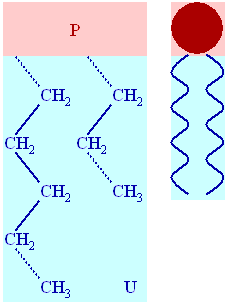Lipid
|
|

The term lipid comprises a diverse range of molecules and to some extent is a catchall for relatively water-insoluble or nonpolar compounds of biological origin, including waxes, fatty acids, fatty-acid derived phospholipids, sphingolipids, glycolipids and terpenoids, such as retinoids and steroids. Some lipids are linear aliphatic molecules, while others have ring structures. Some are aromatic, while others are not. Some are flexible, while others are rigid.
Most lipids have some polar character in addition to being largely nonpolar. Generally, the bulk of their structure is nonpolar or hydrophobic ("water-fearing"), meaning that it does not interact well with polar solvents like water. Another part of their structure is polar or hydrophilic ("water-loving") and will tend to associate with polar solvents like water. This makes them amphiphilic molecules (having both hydrophobic and hydrophilic portions). In the case of cholesterol, the polar group is a mere -OH (hydroxyl or alcohol). In the case of phospholipids, the polar groups are considerably larger and more polar, as described below.
Phospholipids or, more precisely, glycerophospholipids, are built on a glycerol core to which are linked two fatty acid-derived "tails" by ester linkages and one "head" group by a phosphate ester linkage. Fatty acids are unbranched hydrocarbon chains, connected by single bonds alone (saturated fatty acids) or by both single and double bonds (unsaturated fatty acids). The chains are usually 10-24 carbon groups long. The head groups of the phospholipids found in biological membranes are phosphatidylcholine (lecithin), phosphatidylethanolamine, phosphatidylserine and phosphatidylinositol, whose head group can be modified by the addition of one to three more phosphate groups. While phospholipids are the major component of biological membranes, other lipid components like sphingolipids and sterols (such as cholesterol in animal cell membranes) are also found in biological membranes.
In an aqueous milieu, the heads of lipids tend to face the polar, aqueous environment, while the hydrophobic tails tend to minimize their contact with water. The nonpolar tails of lipids (U) tend to cluster together, forming a lipid bilayer (1) or a micelle (2). The polar heads (P) face the aqueous environment. Micelles form when single-tailed amphiphilic lipids are placed in a polar milieu, while lipid bilayers form when two-tailed phospholipids are placed in a polar environment (Fig. 2). Micelles are "monolayer" spheres and can only reach a certain size, whereas bilayers can be considerably larger. They can also form tubules. Bilayers that fold back upon themselves form a hollow sphere, enclosing an a separate aqueous compartment, which is essentially the basis of cellular membranes.
Micelles and bilayers separate out from the polar milieu by a process known as the "hydrophobic effect." When dissolving a nonpolar substance in a polar environment, the polar molecules (i.e. water in an aqueous solution) become more ordered around the dissolved nonpolar substance, since the polar molecules cannot form hydrogen bonds to the nonpolar molecule. Therefore, in an aqueous environment, the polar water molecules form an ordered "clathrate" cage around the dissolved nonpolar molecule. However, when the nonpolar molecules separate out from the polar liquid, the entropy (state of disorder) of the polar molecules in the liquid increases. This is essentially a form of phase separation, similar to the spontaneous separation of oil and water into two separate phases when one puts them together.
Lipid_bilayer_and_micelle.png
The self-organisation depends on the concentration of the lipid present in solution. Below the critical micelle concentration the lipids form a single layer on the liquid surface and are dispersed in solution. At the first critical micelle concentration (CMC-I), the lipids organise in spherical micelles, at the second critical micelle concentration (CMC-II) into elongated pipes, and at the lamellar point (LM or CMC-III) into stacked lamellae of pipes. The CMC depends on the chemical composition, mainly on the ratio of the head area and the tail length.
Lipid bilayers form the foundation of all biological membranes and of liposomes.
See also
External links
- Lipids, Membranes and Vesicle Trafficking - The Virtual Library of Biochemistry and Cell Biology (http://www.biochemweb.org/lipids_membranes.shtml)
- IUPAC glossary entry for the lipid class of molecules (http://www.chem.qmul.ac.uk/iupac/class/lipid.html) what is IUPAC?ca:Lípid
da:Lipid de:Lipide es:Lípido eo:Lipido fr:Lipide is:Fita it:Lipidi lv:Lipīdi nl:Lipide ja:脂質 pl:Lipid pt:Lípido su:Lipid fi:Lipidi sv:Lipid vi:Lipit he:ליפיד
